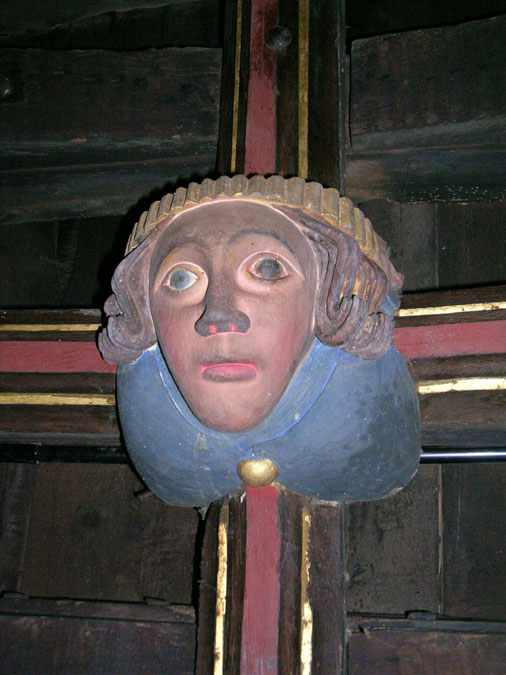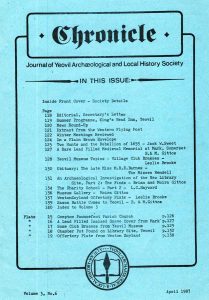This article came from the Chronicle published April 1987. Page: 120-121.
News Round-up – April 1987
BREAN DOWN, SOMERSET: The remarkable chance discovery of two Bronze Age gold bracelets occurred during a visit to Brean Down in March 1983 by Dr.Crabtree and a party of geography students. This led to an excavation of the site in September 1985 by St.David’s University College, Lampeter. Associated with a covering of up to 5m. of blown sand and eroded soil, evidence was revealed of a long period of use of the site from the middle Bronze Age to an early Christian cemetery of c.700 AD. This important site is on National Trust land but is suffering severe erosion by the sea such that further excavation may be required in the near future.
Current Archaeology: No.102 Nov.1986
HINTON ST.GEORGE, SOMERSET: Part of Hinton House has been offered for sale through Humberts of Yeovil. For many years it was the home of the Poulett family and the present building dates from 1630-40 with a facade of c.1700 and many 18th century features. Ron Gilson demonstrated the external features of Hinton House when our Society visited Hinton St.George in April 1985.
Western Gazette: 23.1.87.
ILCHESTER, DOLPHIN LANE: The excavations conducted by the Birmingham University Field Archaeology Unit at Dolphin Lane, Ilchester during September 1986 revealed some new information about the Roman Town. The more northerly of the two trenches which were dug produced evidence of what was interpreted as a Roman street running approximately east/west with at least six re-surfacings apparent. The more southerly trench cut through part of a late Roman building but unfortunately the walls had been destroyed by stone robbing. There was also considerable disturbance of the site by medieval rubbish pits dating from the llth to 13th centuries. It is hoped that further work will be undertaken in this area in the future.
Interim Report by Peter Leach &
John Casey December 1986.
MIDDLEHAM, YORKSHIRE: One of the most remarkable metal detector finds has been sold at Sotheby’s for almost £1.5 million. It is a 15th century gold pendant adorned with a large saphire, described as the “Middleham Jewel”
because it was discovered in a cow field near Middleham Castle, North Yorkshire. It was found by Mr Ted Seaton who will share the proceeds with the land owner, the tenant and two friends who assisted him. The pendant which was acquired by an anonymous buyer is thought to have had a religious purpose.
Daily Telegraph: 12.12.86.
POOLE, DORSET: Six months excavation work at Poole, Dorset have revealed a medieval shipyard in the harbour area up to ten feet below street level. Rescue archaeology was carried out following the demolition of a Victorian quayside iron foundry and prior to the building of a new office block. Timbers from at least two 500 year old galleons were uncovered including the oak ribs of a 40 ft coaster which may be reconstructed.
Daily Telegraph: 31.1.87.
POUNDBURY, DORSET: Some 1,400 skeletons excavated from an early Christian cemetery at Poundbury have been subject to analysis, yielding interesting results. Bone lead levels were approximately twice what would be found today, which would be sufficient to cause chronic anaemia, fatigue and a reduced resistance to disease. Up to 50% of adults died before they were 45. The source of the lead is not thought to be water pipes as is commonly believed but more probably the Roman custom of boiling grape juice in lead cauldrons, producing syrups contaminated with lead acetate. The large number of burials suggests a significant Christian community living in Dorset as early as 300 AD.
The Independent: 10.11.86.
WHATLEY, SOMERSET: After many delays and much debate about the method to be employed work at last began during December 198§ on the conservation of the 14th,C. military effigy and tomb chest in St.Georges, Whatley. The tomb chest has been suffering from ingress of damp due to its situation against the south wall of the south chapel. The tomb chest was dismantled and taken to Wells for conservation but the effigy will have to be treated in situ because of its size. During dismantling, detail was found on the end panel which had previously been hidden by the east wall of the chapel. Another bonus was the discovery beneath the tomb chest of the medieval footings of the original south wall of the chapel. The effigy is particularly fine, showing interesting details of mid 14th century armour and it is a relief to know that action is finally being taken to rescue the monument from the ravages of damp and green algae.
YEOVIL, BAPTIST CHURCH: Severe dry rot is blamed for the poor state of the Baptist Church in South Street. An application to demolish it and redevelop the site to include a new church and offices has been made. It was intended to preserve the facade of the Newnam Hall which is also to be demolished but pressure has been growing for preserving the facade of the church as well. [This has presented the YALHS with something of a dilemma, having an interest both in the preservation of the building and also the, archaeological prospects afforded by its demolition! Preserving the facade might be a useful compromise. Ed]
Western Gazette: 20.2.87.
YEOVIL, PETTERS WAY: The recent decision to go ahead with a new information centre on the site currently occupied by public toilets at the edge of Petters Way car park, may provide some new archaeological opportunities this year. The site is only a few hundred yards from the library site monitored 1986.
For details of the new building see Western Gazette: 23.1.87.
YEOVIL, SUMMERHOUSE HILL: A brief examination has been made of the earth disturbance on the north western side of Summerhouse Hill during the construction of Yeovil’s artificial ski slope. No features were apparent and the finds were unremarkable. They included trimmings from leather working, a few sherds of (possibly) medieval pottery and many fragments of clay pipe. One of the fragments of clay pipe stem was inscribed on both sides as follows : “GROUT & on one side and “…ON ST. S.W.” on the other. Consulting Adrian Oswald’s “English Clay Tobacco Pipes (J.B.A.A. Vol.23,1960), there is only one entry for Grout,’viz.,E.Grout operating in Clapham 1852-62 which seems to fit the inscription well and is in keeping with the style of some of the other fragments.
YEOVIL, WESTLAND ROAD: The Civil Service Sports Council have indicated that they would like to dispose of their derelict tennis courts in Westland Road. The District Council are considering purchase of the site which covers part of the Westland Roman Villa excavated in 1927 and 1928. This important site had previously been threatened by housing development but its preservation might soon be assured.
Western Gazette: 16.1.87.

